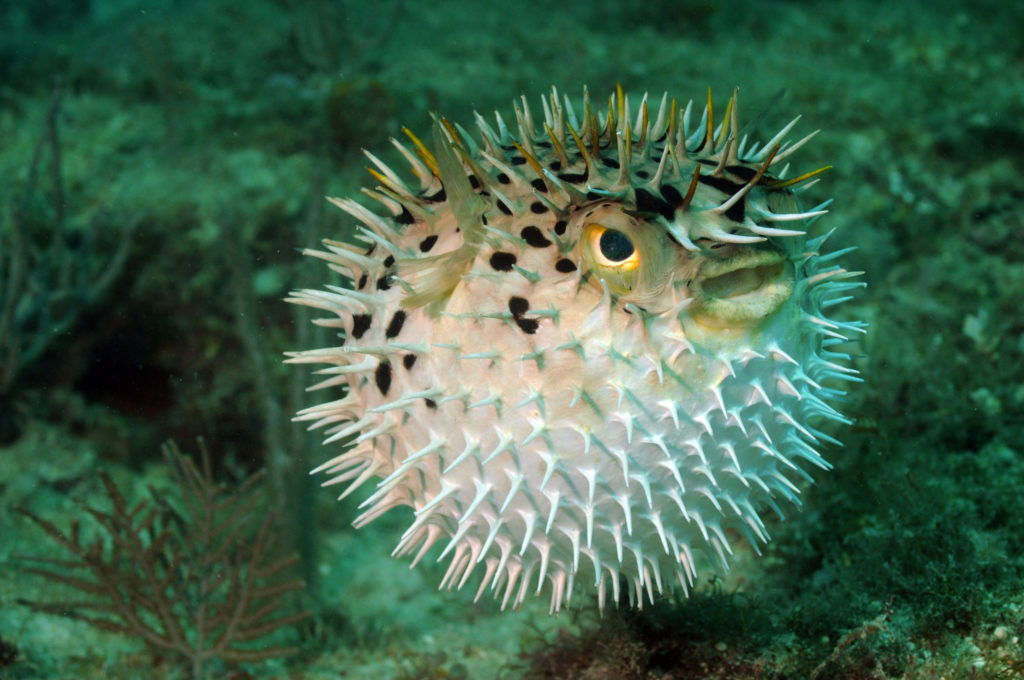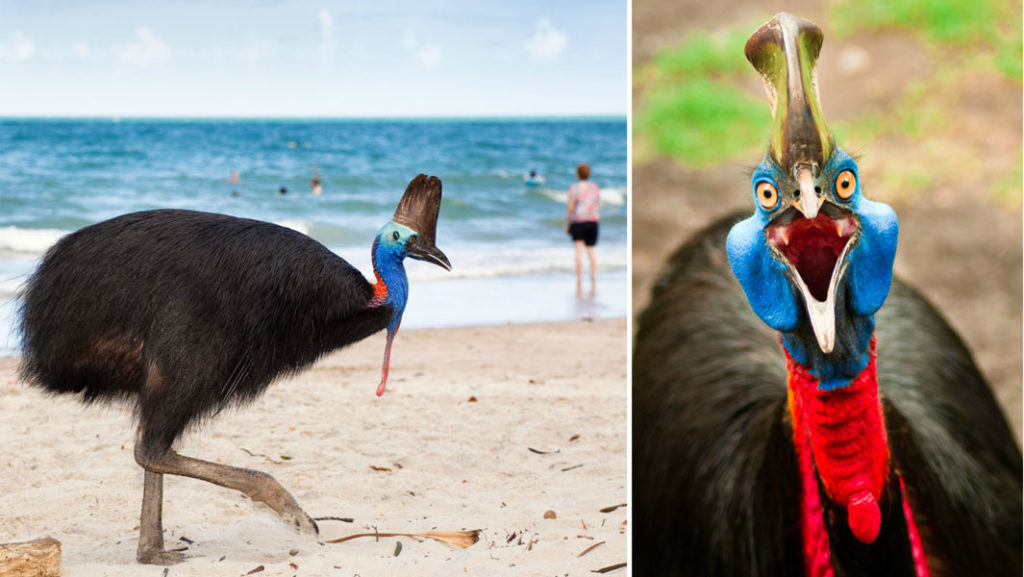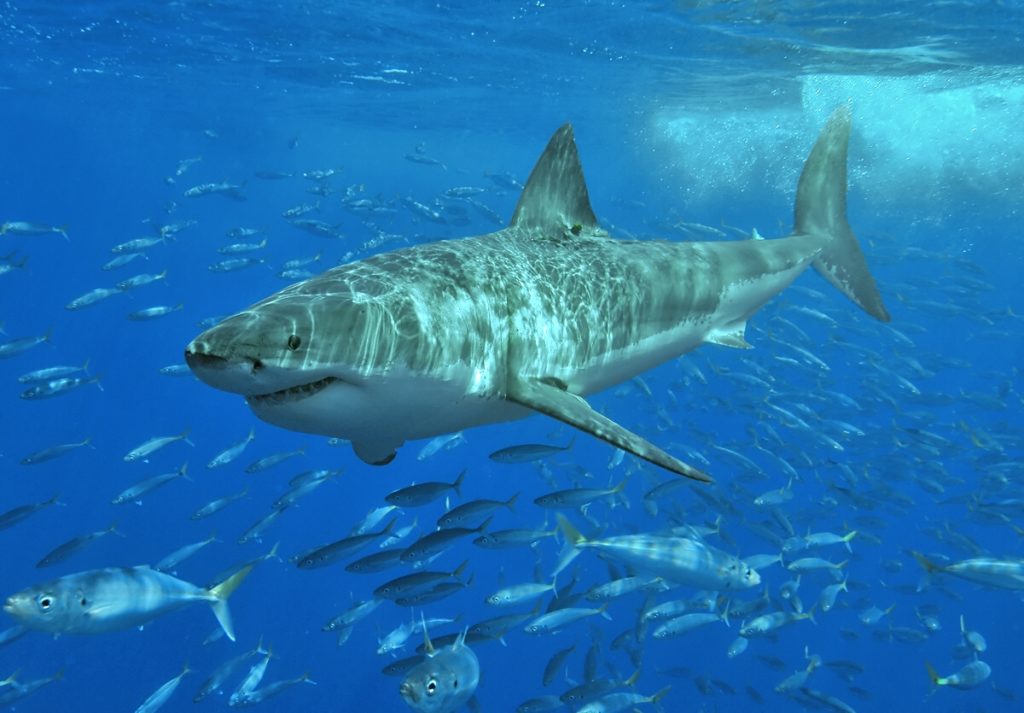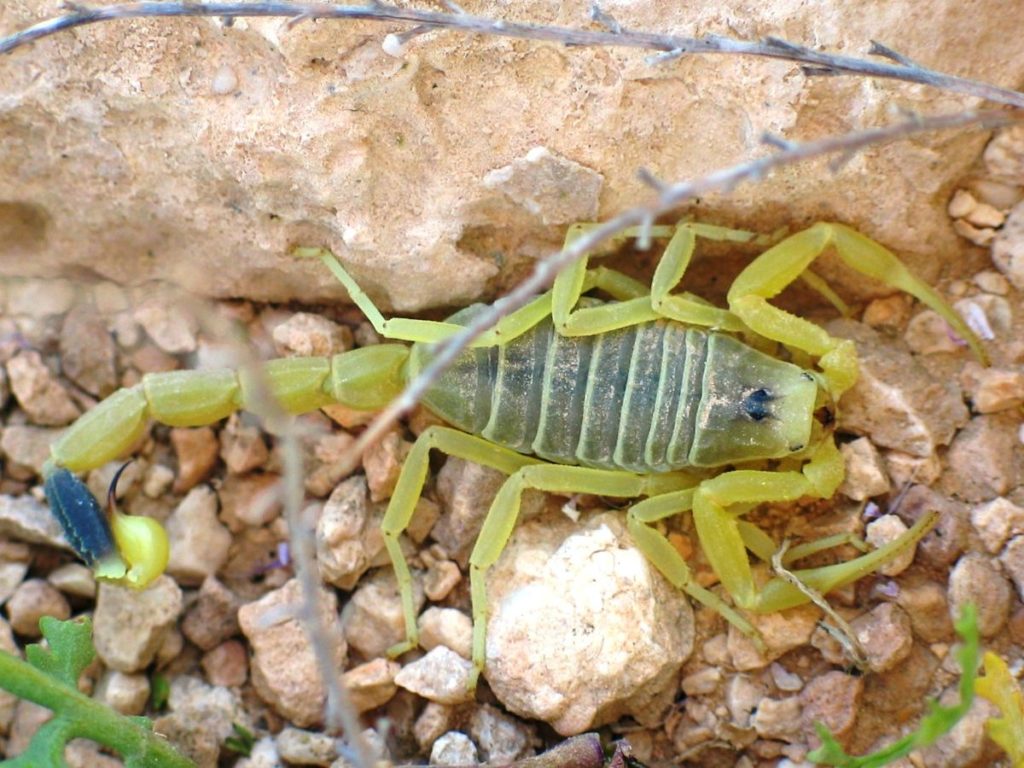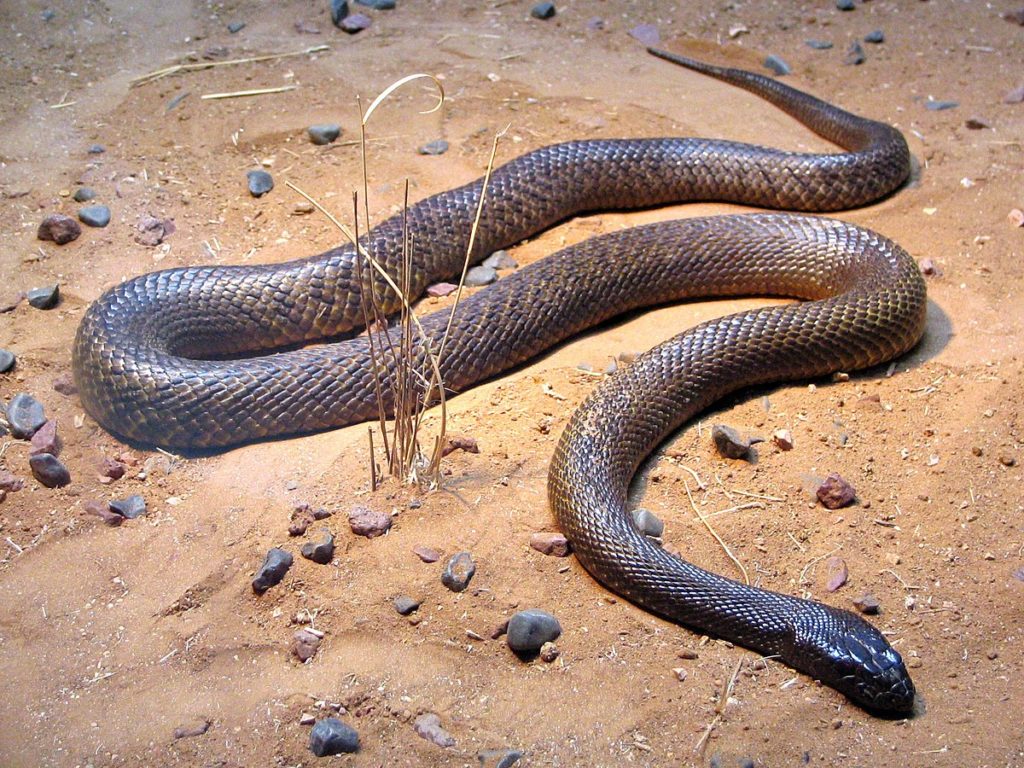Intro
We are here on the Blind Side, The world is a pretty dangerous place. There are wars, precarious places to visit, not to mention violent people. And then there are the animals that were probably here first, and wouldn’t mind letting us know it. From a snake we like to call a nope rope, to a frog that can take down ten grown men, here are 15 of the most dangerous creatures in the world.
15. Giant Centipede
The fear point of this creature is in the name: giant centipede. It’s massive when you compare it to other centipedes, and its legs don’t make it look any less terrifying, either. But it’s not so much its size that makes this critter one of the most dangerous animals in the world: it’s the toxins it has within.
Giant centipedes use their fangs near their mouths to inject toxins into their prey. They can also use their legs, which make tiny incisions into skin or bodies. Any lizard, cockroach, insect, or arachnid that the centipede targets as lunch will be injected with a type of venom that paralyzes it and deems it unable to move before it’s eaten.
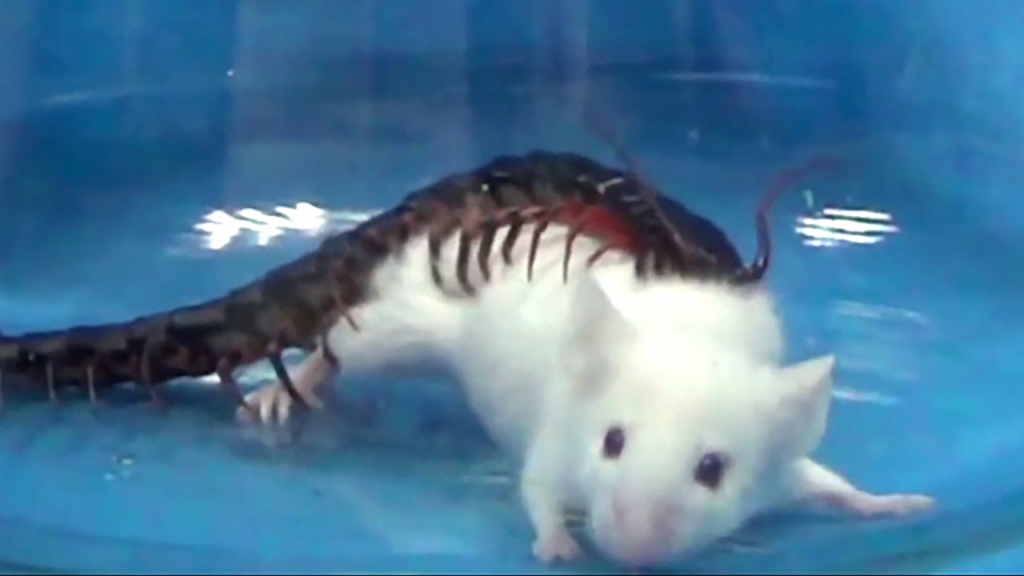
If a human gets bit, the venom can cause pain, swelling, skin necrosis, headaches, nausea, dizziness, muscle damage, kidney failure, and heart attacks. Of course, the latter is at the rarer end of the scale.
Up until recently, scientists didn’t know what was in the venom, or how it made it capable of taking down rodents, toads, snakes, lizards, and most creatures around 15 times their size. They purified the toxins from the golden head centipede that lives in eastern Asia, then tested them one by one.
They managed to identify one called Ssm Spooky Toxin, which shuts down the channels in the body that push potassium through your cells. These channels are vital for bodily functions such as your heart rate and brain waves. Now that they know the likely problem toxin, they can work on an antidote. Until then, notice the bright colors of the centipede and stay well away from it!
14. Pufferfish
You don’t have to be a marine expert to have heard of the pufferfish. Most people learn from a young age what this fish is, how to identify it, and why you should stay away from it. There are over 120 different species, and they all boast different characteristics. They can live in saltwater, freshwater, or brackish water, which is a mixture of both. They can be as small as a few inches or as large as several feet.
When pufferfish feel under threat, they puff up – hence the name. Some have spines to ward off other fish, but many other marine species know that this fish doesn’t provide the best dinner. Not only do they taste dreadful, but they are toxic and can kill whoever dines on them. Humans included. Even though pufferfish is a delicacy in Japan, it is only prepared and served by licensed and trained chefs who know how to remove the toxins before serving.
The pufferfish have enough venom to end the lives of around 30 humans, and there is no known antidote. Even though this fish is intriguing, it’s one you are going to want to observe from afar.
13. Black Mamba Snake
Around 20,000 people lose their lives to snake bites in Africa every year, and you can nearly guarantee that the Black Mamba snake is to blame for many of them. This brown, olive, and gray snake, which grows to around 14 feet long, is one of the world’s deadliest snakes.
It’s aggressive, fierce, and fast. It’s known as the fastest land snake in the world, the longest venomous snake in Africa, and the second-longest in the world. And best for last, it takes no prisoners.
If you threaten a Black Mamba snake, which gets its name from its black mouth, you’re bound to be in serious trouble. This snake will strike repeatedly and injects venom with every attack launch. It will give you a warning first as a common courtesy by opening its mouth, but then it’s time to run.
Unfortunately, this nope rope can slither faster than most people can sprint at 12 miles per hour, so you’re going to want to put on your best Usain Bolt speed when you come across this snake in Africa.
12. Tse Tse Fly
A fly. Harmless, right? After all, flies buzz around you every day, and you live to tell the tale. That might be the case with most flies, but not the Tse Tse variety.
The Tse Tse fly’s bite is not so much dangerous as uncomfortable. Instead of inserting its mouth into your skin as a mosquito would do, it uses its tiny serrated teeth to saw into your skin and suck out your blood. This process can hurt and sting, but even then, it’s not the bite that makes it dangerous, but the diseases it can carry.
One of the most common diseases for this insect to carry is human African trypanosomiasis, more commonly known as the sleeping sickness. It’s a neglected disease that has not had a lot of research and funds thrown into it but has been responsible for thousands of cases and a myriad of deaths.
It causes fever, headaches, and tired muscles, and then it spreads to your brain. While it can be treated, it can be fatal once it reaches the brain – and treatment at this stage is more detrimental than beneficial.
Hundreds of thousands of people came down with the sleeping disease in the 20th century, but it was under control by the 1960s. However, there have been plenty of outbreaks since. Fortunately, better screening and management see a few thousand cases every year, rather than a few hundred thousand, and there are hopes that it will be eradicated by 2020.
11. Blue-Ringed Octopus

The blue-ringed octopus looks like an innocent creature of the ocean. It’s brightly-colored, small, and just relaxes on coral reefs and in shallow tide pools. But it’s only a matter of time before this octopus shows its true colors, and it’s in the form of a blue ring.
When a blue-ringed octopus feels threatened, vibrant blue rings will form on its body to warn you off. At this point, you need to back away! Its venom is around 1,000 times more potent than cyanide and can take down around 26 humans with it.
If you are bitten, you may not feel it, for its bite is generally painless. But it’s the symptoms that follow that will let you know that you have been. You may feel nauseous before you experience vision loss, muscle numbness, and a loss of your motor skills and senses. Muscle paralysis then leads to respiratory arrest, with the only known cure to begin artificial respiration immediately.
While there’s a chance that humans will survive a blue-ringed octopus attack, its prey isn’t so lucky. Creatures it sees as food, such as crabs, small fish, and shrimp, don’t stand a chance. The octopus will peck through its exoskeleton and insert its venom to begin the muscle paralysis process. While the creature is paralyzed, the octopus will pull off all its meat until only the shell remains.
There hasn’t been a human fatality since the 1960s, so let’s keep it that way. The blue-ringed octopus is a marine creature you should observe from a safe distance.
10. Cassowary
Who would have thought that a simple bird could cause so much chaos and destruction? In the case of a cassowary, it’s not unexpected. This violent emu-like bird is one that takes no prisoners and has been responsible for human fatalities. It has also taken down dogs, cats, other birds, and virtually any other animal that gets in its way or territory.
The cassowary can peck, head-butt, kick, and barge. They are even more dangerous if you are on the ground, lying down, have your back to them, or are bending over. Even casually walking past them and looking at them the wrong way can see them unleash a barrage of Jackie Chan moves. This bird is not one you’ll want to cross – even if it’s in a good move.
If it sees its own reflection in the glass, it will smash its way through it to end the threat, and the injuries you can sustain are quite fierce. Puncture wounds, bone fractures, and severe lacerations go hand in hand with a cassowary attack.
Dogs and cats are frequent victims of a cassowary, but there have also been cases of attacks on cows and horses as well. Essentially, nothing is safe if a cassowary has woken up on the wrong side of the bed. Anyone who keeps this bird captive also learns quickly not to house it with other species. The safest thing you can do is not to keep them at all. Or even look at them the wrong way.
9. Rhinoceros
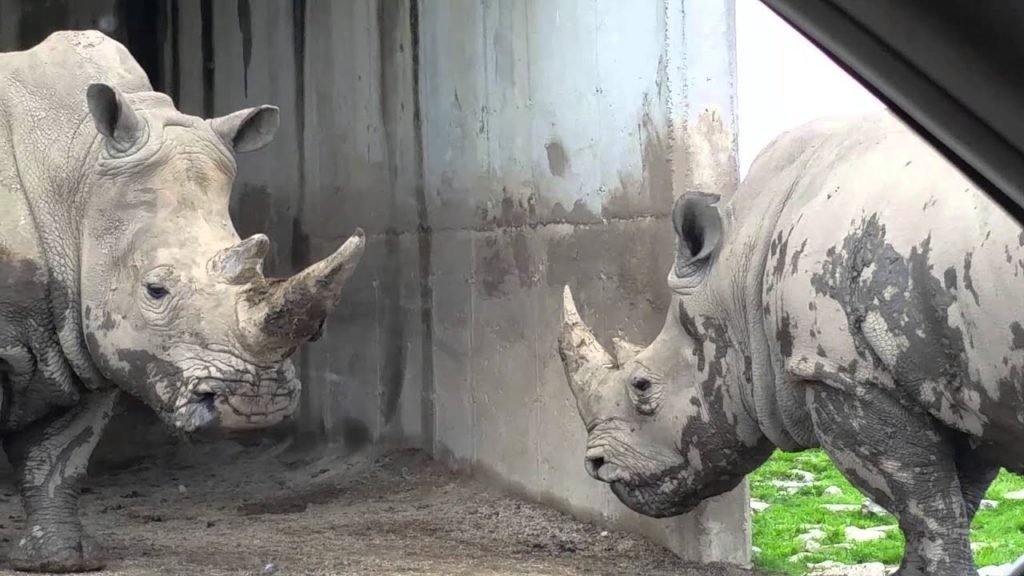
Most people who have the rewarding experience of seeing a rhinoceros will remark at how docile they seem. They keep to themselves and are primarily solitary creatures that don’t interact with others of their kind – or any other animals. But if you place them in a potentially dangerous situation, then don’t expect the rhino to take it lying down.
Because they have poor eyesight, they have unpredictable behavior. If they sense a threat, they move into self-defense mode. They protect themselves, their young, and other rhinos around them. During the two years that their calves stay with them, they are hyper-vigilant and will even ward off lions who try to indulge in a rhino baby entrée.
Fortunately, this animal is peaceful for the most part, but they are endangered. Out of all potential predators, the human is the worst – with rhino horns seen as valuable enough to end this beautiful creature’s life for.
8. Great White Shark
The Great White Shark forms the plot of many horror marine movies. They are seen as ferocious, terrifying, and vicious sea creatures that will maim without any prewarning. Even though there are up to ten shark attacks every year, researchers believe it’s curiosity that sees them take a bite of humans, rather than malicious intent.
Great White Sharks prefer to dine on fish and rays when they are young but move up to whales, seals, and lions once they reach maturity. They often get their prey by positioning themselves underneath them, then attacking from below with their seven rows of 300 triangular-shaped teeth.
Along with their bite, their sense of smell is quite powerful too. One drop of blood is enough for them to sense dinner from a long way off. They can even smell seals around two miles from the colony.
The Great White Shark lives in cool, coastal waters and can swim at speeds of up to 37 miles per hour. They also grow to around 15 feet long and are thus considered the largest predatory fish. Even though these sharks don’t always attack humans when they see them, there’s no reason to take the risk. Shark-infested waters are most certainly not where you want to spend your free time.
7. Saltwater Crocodiles
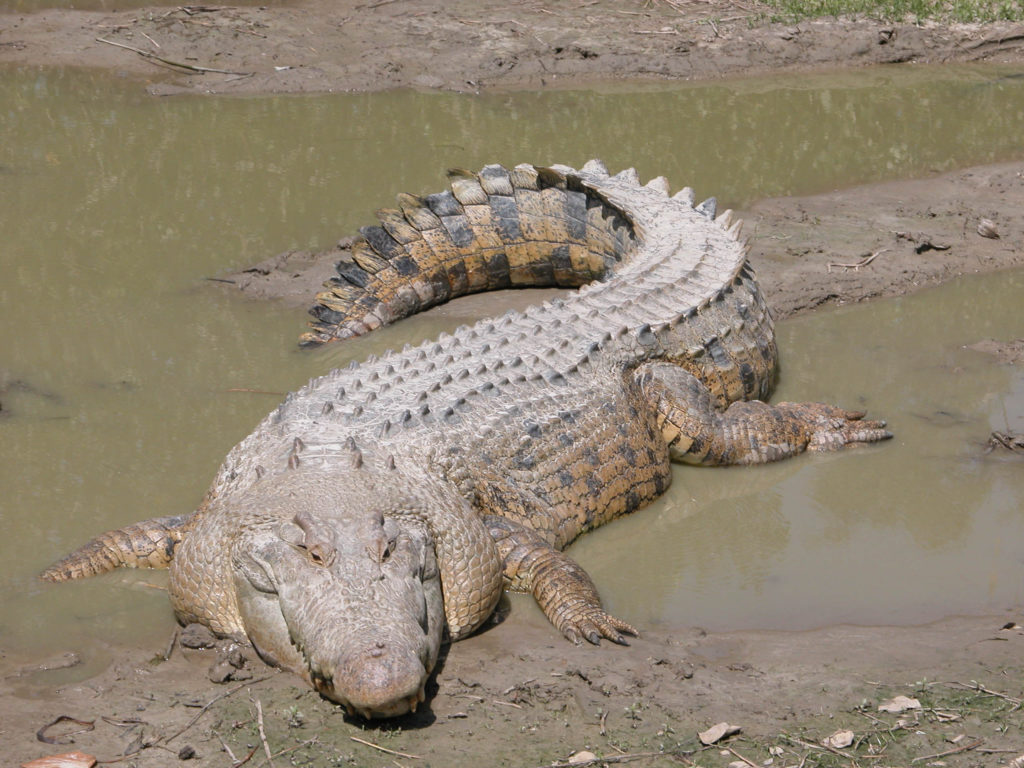
Saltwater crocs are the largest living reptiles, measuring in at an average of 16 feet and around 1,100 pounds. They are adaptable to all environments and can live in most bodies of water – including the ocean, where they can swim hundreds of miles to get to their destination.
Their adaptability and ferociousness are what make the saltwater croc one of the most dangerous creatures in the world. They live in bodies of water from northern Australia through to Asia, and they can take down any animal that stands in their way. Sharks, humans, fish, birds, and mammals are all on the menu.
The saltwater crocodile is even a threat when it’s asleep. It sleeps with one eye open, with half its brain awake and alert to danger, and the other side getting some much-needed rest. There’s no way you’d be able to sneak up on this restless reptile.
They also live for several years, so there is plenty of time for them to finetune their preying tactics. Most live to more than 65 years old, and some are well over a century old. Fast on water and land, many a human has been gobbled up by this critter. It’s best to stay away from any body of water where these creatures could be hiding.
6. Hippopotamus
If you see a hippopotamus in a children’s book, they are rotund, gentle-looking creatures that wallow in water all day without a care in the world. The reality is really quite different. Hippos are aggressive, fast, and unpredictable. They have no qualms about taking down everything from cattle to children. Nothing is out of reach.
Hippos live in pods or bloats and have large teeth and even more giant mouths to hold them. When you see them yawn, it’s not fatigue that’s causing it. Their yawn is a way to show their aggression, and they battle it out with other hippos regularly.
Anything they perceive as a threat is not safe when a hippo is around. They have been known to charge at happily grazing cows, and about 3,000 people lose their lives to these unpredictable and rotund creatures annually. They can run at speeds of around 14 miles per hour, and even took down an entire school boat of children in Niger. A villager and 12 children lost their lives. The hippo might look like a picture of peace, but it’s far from it.
5. Deathstalker Scorpion
Something that only measures up to three inches long and 2.5 grams in weight doesn’t seem like it will be all that much of a threat. It’s no hippo, that’s for sure. But the deathstalker scorpion, also known as the Palestinian Yellow Scorpion, is an equal a fear as a Great White Shark or a charging rhinoceros.
They live in North Africa, the Middle East, and Asia, and tend to prefer an area with high temperatures, such as arid and semi-arid deserts. They also feed on most other insects of the same or smaller size and carry out their grocery shopping at night.
While they tend to stick with small creatures for dinner, that doesn’t mean this frightful little scorpion isn’t capable of taking on you or me. A sting from the deathstalker scorpion is not only painful but potentially fatal. It can see the death of older adults and children and causes both heart issues and pulmonary edemas. This fluid build-up in the lungs can be fatal.
This animal might not be the largest in the animal kingdom, but there’s no denying it’s one of the most dangerous.
4. Box Jellyfish
Getting stung by a box jellyfish is like playing a game of Russian roulette. Even though they are one of the most dangerous creatures in the world, not all species carry the venom that can see you swimming with the fishes. But you are not going to want to take any risks.
The largest box jellyfish of the venomous variety can grow up to one-foot long and thick, with tentacles as long as ten feet. These tentacles are covered with poison-loaded darts that take no prisoners. One attack by a box jellyfish can and will cause your heart to stop, and there are very few cases of survival.
A ten-year-old Australian girl did survive an attack, but marine biologists and doctors are baffled as to how.
Those who are attacked by box jellyfish experience a range of symptoms before they eventually succumb to their injuries. Paralysis, cardiac arrest, and death are all standard. It is thought that more than 100 people are fatally injured every year, but the lack of detailed death certificates in places with the largest box jellyfish population could see this figure dramatically underestimated.
Most of the lethal varieties are found in northern Australia and Indo-Pacific regions, so maybe steer clear of these areas if you want to reduce your risk of coming into close contact with them!
3. Golden Poison Dart Frog

The golden poison dart frog from Northern South America looks innocent, but don’t be fooled. This angelic amphibian is anything but innocent. Even at no more than 2.5 inches long, they can take down ten grown men with their venom and are thought to be one of the most poisonous animals in the world.
The golden poison dart frog has poison glands within its skin, and the poison is called batrachotoxin. When it enters your bloodstream, it causes paralysis, followed by death. Smaller animals that end up as victims suffer from respiratory paralysis, seizures, skyrocketing blood pressure, followed by death. Both young and old golden poison dart frogs are dangerous and should not be approached. This is one frog you are not going to want to kiss, for you won’t meet a prince, but your maker instead.
2. Inland Taipan
You may have picked up a common theme here, that several dangerous animals live in Australia. We’re about to add another one – the inland Taipan.
The Inland Taipan is a venomous snake in central east Australia. It lives in semi-arid areas and is the most toxic of any sea or land snake. One bite with 110 milligrams of venom is enough to end the lives of 250,000 mice or around 100 human adults. Left untreated, survival time is about 45 minutes for an adult.
Fortunately, even though the inland Taipan is not a snake you would want to mess with, it’s not about to attack unprovoked. It’s a shy snake and prefers to slither away from trouble rather than face it head-on. If it does sense trouble, it will fire a warning shot first. It arcs up in the shape of an S. If that warning is ignored, it unleashes a barrage of accurate and fierce lunges that can take down almost any animal.
The Inland Taipan will grow up to around six feet long, but there have been some found that are even as long as eight feet. If you see a dark tan or brown and green snake slithering around near you, there’s every reason to believe it’s a Taipan, and that you should stay well away!
1. Cone Snail
Nickelodeon’s Spongebob Square Pants taught us that snails are harmless creatures that you can keep as pets and give human names, such as Gary. But the cone snail derails that story entirely.
The cone snail, which lives in bodies of water around Indonesia, Hawaii, and the Caribbean, is a slow-moving but fast-attacking sea creature that lounges around coral reefs and sea beds. It feeds on marine worms, other snails, and fish, and uses a needle-like proboscis to inject venom into its prey. This venom has pain-killing analgesic properties, which means that if you’re stung, you’re unlikely to feel it.
Cone snails don’t seek out humans, but they will attack when provoked. Divers are the more frequent victims, for they may accidentally stand on them while diving. Even the strongest diving gloves are no match for the injection of a cone snail, for they are adept at breaking through the hard shells of sea creatures.
Even days after the attack, you may still not know you have been attacked by a cone snail. You might only feel numbness and tingling. There is no anti-venom, but you can prevent the spread of the toxins by trying to remove them from the injection site.
Even a few microliters of this venom is enough to end the lives of up to ten people. Fortunately, there have only been a few dozen deaths. Scientists are currently studying the poison to see if it can isolate its painkilling properties for future use. Hopefully, in this process, they stumble across an antidote.
Outro
So, there you have it, folks. Here are 15 of the many dangerous animals out there that you are best to avoid! Can you think of any others? Have you come across any of these on your travels and adventures? Also, check out our other cool stuff showing up on the screen now. See you next time.
